Abstract
This review recounts the development by the authors of the Pd-catalyzed procedures devoted to various kinds of oxidation. Starting with reactions assisted with UV light, the research has explored reactions under light-free conditions: allylic oxidation, alcohol oxidation, etherification, Wacker oxidation and dehydrogenations with, always, accompanying efforts towards mechanism determination.
1. Introduction
Our initial studies on Pd-catalyzed oxidations results from our observation in the early 1980s of the formation of unsaturated carbonyl compounds from irradiation with UV light of bis(µ-chloro)bis(η3-allyl)dipalladium complexes in oxygenated acetonitrile (Scheme 1) [1]. That result urged us to look for such reactions under catalytic conditions. This activity progressively led us to study a variety of Pd-catalyzed oxidations under light-free conditions. The aim of the present account is to highlight the main results that we obtained in the area over the years.

Scheme 1.
Photocatalyzed oxidation of bis(µ-chloro)bis(η3-allyl)dipalladium complexes
2. UV-Light-Assisted Oxidation
2.1. Ethylenic Compounds
The easy formation at room temperature of η3-allylpalladium complexes from alkenes and Pd(OCOCF3)2 reported by Trost and Metzner [2] urged us to use this Pd salt as a catalyst for the photo-assisted oxidation of alkenes [3,4]. For an example, the reaction of 1-eicosene (1) in MeCN/CH2Cl2 afforded a mixture of saturated and unsaturated ketones 2 to 4 (Equation (1)). Some migration of the double bond of 1 was a competing reaction [5,6]. In contrast to the isomerization, ketones 2 to 4 were not produced in the absence of light. Switching to acetone as the solvent increased the ketone yields. Similar results were obtained using [(η3-CH2CHCHC3H7)Pd(OCOCF3)]2 as the catalyst whereas the turnover number was inferior to 1 with Pd(OAc)2 [4]. Under alkene-free conditions, monitoring the irradiation of an acetone solution of Pd(OCOCF3)2 showed the adsorption of oxygen [4]. That led us to suspect the formation of peroxydic species. Nevertheless, ketones 2 to 4 were also produced from the reaction of 1 in the presence of radical and 1O2 traps [4].


The process was used for the oxidation of allylsulfones [7]. Under the above conditions, 5 led to a mixture of unsaturated aldehyde 6 and alcohol 7 (Equation (2)). The yields were improved with a cocatalyst such as Cu(OCOCF3)2 or Co(OCOCF3)2.


Under both Pd(OCOCF3)2 catalysis and UV light, allylsulfones substituted with a trimethylsilyl group underwent cleavage of the allyl-Si bond. Thus, full conversion of 8 occurred in 38 h leading to 6 in 95% yield (Equation (3)) [8]. Lower conversions were mediated by other Pd catalysts.


The mechanism of the reaction of allylsilanes was studied using l-phenyl-3-(trimethylsilyl)-l-propene (9) and l-phenyl-1-(trimethylsilyl)-2-propene (10) as substrates, and comparison with the reactivity of corresponding allylpalladium chloride 11 [9]. The latter would be dissymmetric due to the different substitution of the allyl unit extremities [10,11,12]. Cinnamaldehyde (12) was selectively obtained from irradiation of either 9 and 10 in the presence of catalytic Pd(OCOCF3)2, or 11 (Scheme 2). That contrasts from oxidations of the free phenylallyl radical which gave mixtures of oxidation products in 1- and 3-position [9,13,14]. Consequently, the regiospecificity of the reactions of 9, 10 and 11 excluded the formation of the free phenylallyl radical. The formation of η3-allylpalladium complexes from allylsilanes and PdII salts is known [15]. Thus, a common intermediate, which would be a dissymetric η3-allylpalladium complex, has been proposed (Scheme 3). Light-mediated cleavage of the longer C–Pd bond would lead to intermediate 3A [16,17] which reacts with oxygen to afford a peroxopalladium complex. The latter evolves towards aldehyde 12, liberating HOPdX which would be involved in the subsequent catalytic cycle.
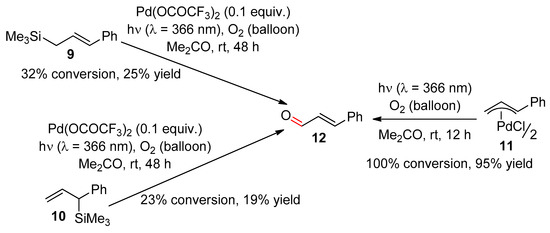
Scheme 2.
Three photochemical reactions leading to cinnamaldehyde.
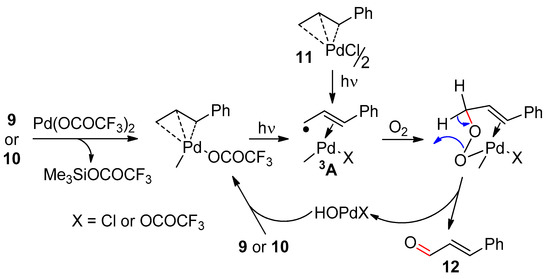
Scheme 3.
Plausible reaction pathways leading to cinnamaldehyde from allylsilanes 9 and 10.
2.2. Alkanes
Irradiation with UV light of a MeCN solution of adamantane (13) containing trifluoroacetic acid and catalytic Pd(OCOCF3)2 afforded adamantanyl acetamides 14 and 15 in quantitative yields versus the amount of palladium (Equation (4)) [18]. The reaction became catalytic with Cu(OCOCF3)2 as the cocatalyst and provided traces of adamantanyl trifluoroacetates 16. The mechanism of these reactions remains obscure, the %14/%15 ratio indicating a radical or electrophilic process [19].
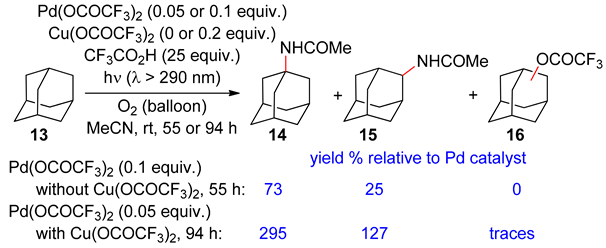

Oxidation of cyclohexane (17) and 3-methylhexane (18) was performed using light and peroxopalladium complexes [20]. Thus, [(t-BuOO)Pd(OCOCF3)]4 in air led, from 17, to cyclohexanol and cyclohexanone with a slight catalytic character (Equation (5)). A similar result arose with [(t-BuOO)Pd(OCOCH3)]4. The oxidation of 18 mainly occurred at the level of the tertiary C–H bond.


3. Allylic Oxidation
3.1. 1-(p-Toluenesulfonyl)-2-Propene and 1-(Trimethylsilyl)-1-(p-Toluenesulfonyl)-2-Propene
The PdII-catalyzed oxidation of allylsulfone 5 was carried out with t-BuOOH or oxygen in conjunction with either CuCl or benzoquinone (BQ) (Equations (6) and (7)) [21]. Under the former conditions, the main products were alcohol 7 and peroxide 19, which could be produced from a η2-olefin palladium complex formed from 5 and t-BuOOPdOCOCF3 (Scheme 4) [22].





Scheme 4.
Pd(OCOCF3)2-catalyzed oxidation of allylsulfone 5 with t-BuOOH.
Submitting allylsilane 8 to the PdCl2/CuCl or BQ system under oxygen mainly led to the desilylated compound 5. (Equation (7)) [21]. Aldehyde 6 and alcohol 7 were concomitantly produced.
3.2. Terminal Alkenes
Various conditions have been reported for the synthesis of allylic carboxylates via PdII-catalyzed allylic oxidation of olefins in carboxylic acids [23,24]. After the observation of the improvement of the Pd(OAc)2-catalyzed allylic acetoxylation of allylbenzene with BQ as the stoichiometric oxidant in the presence of base but with inconsistent yields, we performed the efficient, reproducible and regioselective allylic acyloxylation of terminal alkenes using lithium hydroxide as the additive and propionic acid as the solvent (Equation (8)) [25].
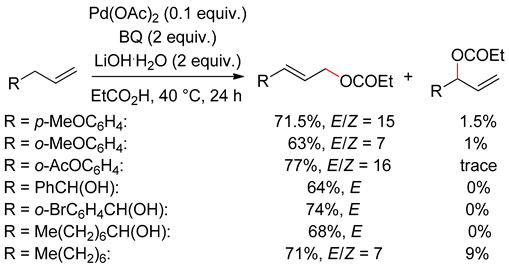

The reaction of 1-decene was less selective (Equation (8)). The regioselectivity increased with the more-hindered pivalic acid but to the detriment of the conversion. Improved results were finally obtained using a BQ/MnO2 mixture as the oxidant (Equation (9)) [25]. This modified procedure was well adapted to the oxidation of homoallylic alcohols but led to lower yields with allylarenes (compare Equations (8) and (9)).
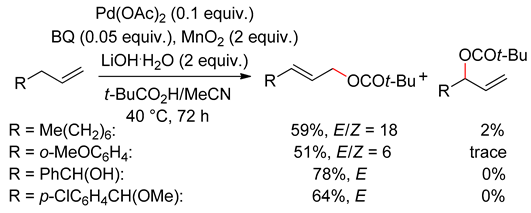

Careful analysis by Electrospray Ionization Mass Spectrometry (ESI–MS) of the allylic acyloxylation under the above conditions led to identification of different clusters, especially those corresponding to intermediates having the Pd atom (in mauve color) in the proposed catalytic cycle depicted in Scheme 5. Palladium acetate, which is a trimer in the solid state [26], reacts with the in-situ formed salt of the carboxylic acid to afford 5A. Coordination of the substrate to 5A leads to η2-alkenyl intermediate 5B, which evolves towards an η3-allyl complex 5C. Subsequent intramolecular acetoxylation delivers the product and Pd0. The reoxidation of Pd0 completes the catalytic cycle.
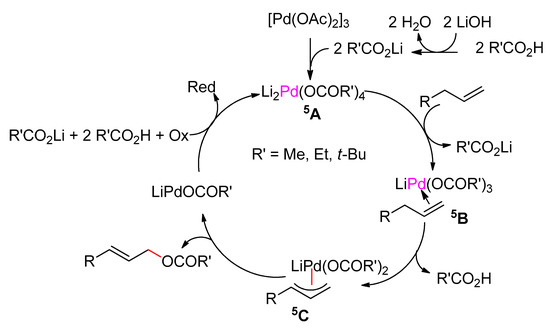
Scheme 5.
Proposed mechanism of the Pd-catalyzed allylic acyloxylation.
4. Alcohol Oxidation
The transformation of alcohols into the corresponding carbonyl compounds with metal oxides and metal salts may occur through three pathways (Scheme 6). Instead of the term “oxidation” used for reactions following paths a and b, those arising via path c are often called “dehydrogenation” or “oxidative dehydrogenation”. Most Pd-catalyzed oxidation of alcohols occur via paths b and c [27]. As shown below, we have developed procedures for such reactions using various species to regenerate the catalyst.
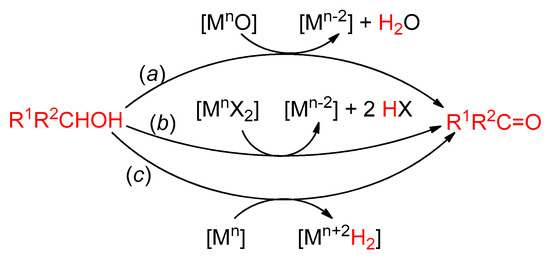
Scheme 6.
The three pathways of metal-mediated oxidation of alcohols.
4.1. With Sodium Percarbonate
Despite its name, sodium percarbonate (SPC) is not a persalt. SPC, which is a versatile oxidizing agent for organic synthesis [28,29], is the association of sodium carbonate with hydrogen peroxide with the formula Na2CO3,1.5 H2O2. In the course of the screening of metal chlorides for the catalytic oxidation of 1-indanol (20) by SPC in 1,2-dichloroethane (DCE) in the presence of Adogen 464 [30], we discovered that the reaction with PdCl2 effectively occurred even in the absence of SPC. That led us to the procedure documented in Section 4.2. In contrast, SPC is required with solvents such as acetonitrile, hexane and benzene, leading selectively to 1-indanone (21) from 20 (Equation (10)) [31].
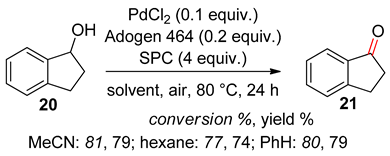

4.2. With 1,2-Dichloroethane
The PdCl2-catalyzed oxidation of alcohols in DCE containing sodium carbonate and catalytic amounts of Adogen 464 (Equation (11)) involves the regeneration of active Pd species by the solvent, leading to the formation of ethylene. The formation of the latter has been highlighted by its reaction with iodine, giving 1,2-diiodooethane [32]. The method is efficient for saturated and benzylic secondary alcohols. Some overoxidation of primary alcohols occurred leading to acids which react with the solvent to afford esters. Isomerization of secondary allylic alcohols to saturated ketones may compete with the oxidation (Equation (11)).
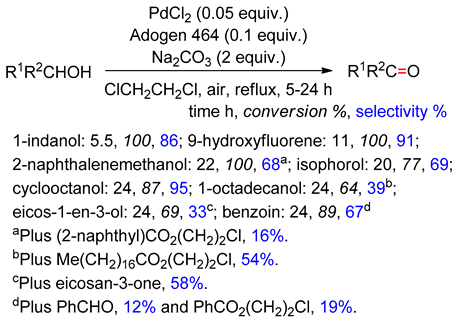

As the plausible mechanism, we initially suspected the insertion of Pd0 into a C–Cl bond of DCE to afford ClCH2CH2PdCl which would undergo β-Cl elimination leading to ethylene and PdCl2 [32]. According to a theoretical study, ClCH2CH2PdCl would rather be the active species reacting with the alcohol [33]. The process is, however, carried out in the presence of Adogen 464 which reacts with PdCl2 to afford the soluble palladium salt [PdCl4]2− [34]. These remarks led us to propose the catalytic cycle depicted in Scheme 7. Hydridopalladium 7A formed after the first alcohol oxidation leads to Pd0 species 7B via elimination of HCl. Insertion of 7B into DCE affords 7C. Coordination of the alcohol to the latter gives 7D. Subsequent elimination of ethylene and HCl leads to an alkoxypalladium intermediate.
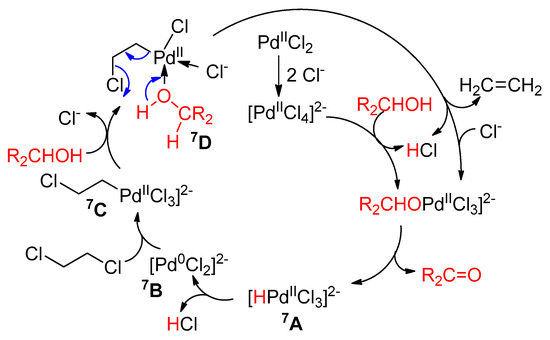
Scheme 7.
PdCl2-catalyzed oxidation of alcohols with 1,2-dichloroethane.
The PdCl2/Adogen 464/DCE procedure effected the lactonisation of various 1,4- and 1,5-diols except that of cis-endo-2,3-bis(hydroxymethyl)bicyclo [2.2.1]hept-5-ene (22) which led to lactol 23 (96% selectivity) (Equation (12)) although the corresponding saturated diol 25 provided lactone 26 (Equation (13)) [35]. Oxidation of lactol 23 into lactone 24 did not occur under the Pd conditions, but arose using pyridinium dichromate in CH2Cl2 (83% yield [36]) [37] or the Swern oxidation method [38]. The PdCl2/Adogen 464/DCE procedure is however able to oxidize α lactol such as 27 (Equation (14)).

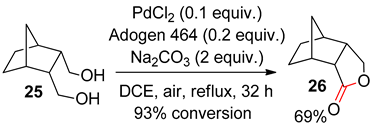




The above results clearly demonstrated that the lack of formation of 24 from 22 under Pd-conditions was attributable to the C=C bond. Analysis of both the plausible intermediates of the process and literature [39,40,41] led to the proposal of Scheme 8. The reaction of hydroxyaldehyde 8B obtained via 8A leads to alkoxypalladium intermediate 8C. Subsequent intramolecular reaction occurs through the stereoselective approach of the alkoxypalladium moiety to one face of the aldehyde to afford 8D. In contrast to the intermediate obtained from 25, 8D undergoes a ligand exchange leading to palladacycle 8E. The syn relationship between O-Pd and C-H bonds, which would allow a β-H elimination leading to the carbonyl unit [42,43], is prevented in 8E. That favors alkoxyde exchange with diol 22 to afford 8F. The latter is in equilibrium with 8B which evolves towards 23, that is, the more stable isomer [44,45,46]. The apparent absence of 23 evolution under the PdCl2/Adogen 464/DCE conditions would be a “no reaction” reaction [47,48], which involves 8B, 8C, 8D, 8E, alcoholysis and equilibration regenerating the starting substrate.

Scheme 8.
The “no reaction” reaction of lactol 23.
As depicted in Equation (11), the PdCl2/Adogen 464/DCE procedure efficiently oxidizes 1-indanol (20) into 1-indanone (21). The oxidation was also effective using the soluble catalyst (n-Bu4N)2PdCl4.0.5 H2O (92% conversion, 90% yield) instead of the PdCl2/Adogen 464 association [31]. Surprisingly, soluble (MeCN)2PdCl2 produced di(1-indanyl) oxide (28) in high yields, even in the absence of the base (Equation (15)) [49].


We rationalized the formation of 21 and 28 through two competitive pathways catalyzed with L2PdCl2 (L = Cl− or RCN), that is with [PdCl4]2− and (RCN)2PdCl2, respectively (Scheme 9) [49]. In contrast to the anionic catalyst (L = Cl-), the neutral catalyst (L = RCN) is electrophilic [50,51,52,53]. Exchange of ligand between L2PdCl2 and 20 affords 9A. The evolution of 9A depends on the electrophilicity of the L2PdCl2. Transition metals having Lewis acid properties mediate the formation of ethers from alcohols [31,54]. Consequently, 9A formed from the anionic catalyst evolves towards 21 via the ketonisation pathway [32,33], while 9A formed from (RCN)2PdCl2 undergoes heterolytic cleavage of the C–OH bond leading to ionic species 9B. The latter reacts with 20 to give ether 28, water and the starting catalyst.
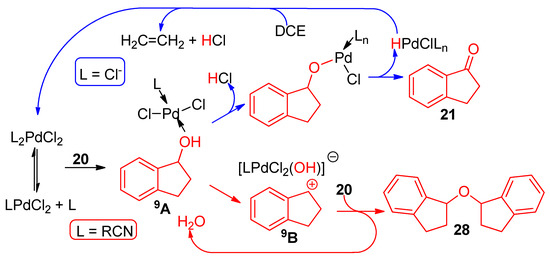
Scheme 9.
Dependence of the reaction pathway on the electrophilicity of the catalyst.
4.3. With Aryl Bromide
The Yoshida procedure of oxidation of alcohols used a Pd catalyst with an aryl halide as hydrogen acceptor and a base (Scheme 10) [55,56]. We used this procedure for the oxidation with high yields of benzyl-protected sugar hemiacetals into lactones (Equation (16)) [57].
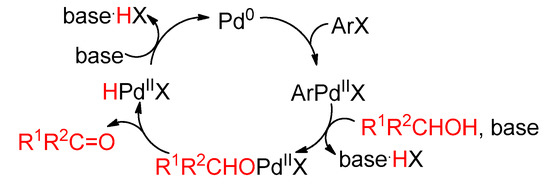
Scheme 10.
PdII-catalyzed oxidation of alcohols with aryl halides.
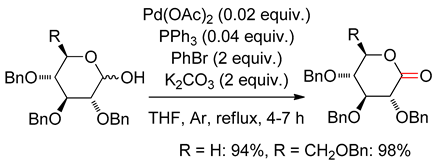
4.4. Dehydrogenation
Over the last thirty years, growing attention has been devoted to the use of ionic liquids and molten salts as solvents for organic synthesis [58,59,60]. The strong interest for catalyzed reactions is due to the immobilization of the catalyst in the ionic liquid or molten salt that would allow the recycling of the tandem catalyst/solvent. These unusual solvents have been used for various catalytic oxidations [61,62,63]. Our above studies with (n-Bu4N)2PdCl4.0.5 H2O (see Section 4.2) and Heck reaction in molten n-Bu4NBr [64] urged us to carry out Pd-catalyzed oxidations in this medium.
Initial experimentation using 20, catalytic PdCl2 and n-Bu4NBr at 120 °C led to a mixture of 21 and indane. The reductive cleavage of the C–OH bond of 19 indicated in-situ formation of hydrogen [65] and/or [Pd]H2 species [66]. Addition of cyclohexene as a hydrogen acceptor increased the selectivity towards 21. Finally, the best result was obtained under a gentle flow of argon which removes hydrogen gas (Equation (17)) [67]. Under these conditions, the recycling of both catalyst and n-Bu4NBr was relatively efficient. Secondary benzylic alcohols provided the corresponding ketones in good yields. The method is less selective for primary benzylic alcohols and is ineffective from allylic and saturated alcohols. Subsequent experiments showed that recycling was more efficient with Pd(OAc)2 than with PdCl2, the yield obtained from 4th reuse of the catalyst/n-Bu4NBr association being 92% (94% conversion) with the former and 64% (67% conversion) with the latter [68].
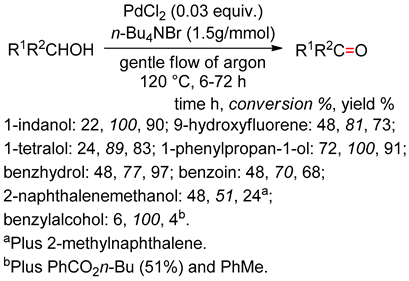

5. Allylphenols Oxidation
Green chemistry has led the chemical community to intensify research on aqueous procedures [69,70,71,72,73,74,75], and we previously used the hydrophilic ligand [(HOCH2CH2NHCOCH2)2NCH2]2 (LH) for copper-catalyzed allylic oxidations in water [76]. The intramolecular Wacker oxidation of allylphenol (29) leads to 2-methylbenzofuran [77,78] or 2H-chromene [79] depending on the reaction conditions. Thus, we were interested in performing such a reaction in aqueous media with a PdII/LH catalytic system.
Treatment of 29 with aqueous H2O2 and catalytic amounts of both Pd(OCOCF3)2 and LH at 50 °C in water afforded diol 30 instead of the cyclization products (Equation (18)) [80]. Reaction in a mixture of water and methanol led to 30 and hydroxyl methyl ether 31Me. Similar compounds were produced in H2O/EtOH and H2O/i-PrOH, or using 2-allyl-4-methylphenol and 2-allyl-6-methylphenol.
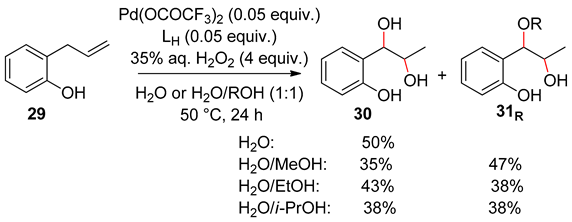

The report of Jacobs’ team about the phenol-mediated epoxidation of alkenes by H2O2 under metal-free conditions [81] led us to propose in 2005 the mechanism depicted in Scheme 11 [80]. Pd-catalyzed isomerization of 29 affords 32 [82]. Activation by the phenolic OH of the epoxidation of 32 provides 11A. The high instability of such a compound [83] brings on spontaneous ring opening leading to 30 and 31R. However, the strong acceleration of the palladium-catalyzed reaction of 32 (Equation (19)) indicates some participation of Pd(OCOCF3)2/LH in the process [80]. In fact, epoxides are very sensitive to Pd catalysis [84]. Complementary mechanistic experiments and ESI-MS studies supported the proposed reaction pathway [85].

Scheme 11.
Domino reaction of 2-allylphenol.

Recycling of the Pd(OCOCF3)2/LH catalytic system led to gradual loss of activity, the 4th reuse in H2O/MeOH yielding 35% and 24% of 30 and 31Me, respectively, from 29 [85].
6. Wacker Oxidation
Tsuji’s conditions of the Wacker reaction use PdCl2 catalyst in DMF/H2O and oxidants such as copper salts/O2 or benzoquinone [86]. According to investigations through isotope effects, kinetic, stereochemical and theoretical studies [87,88,89,90], the mechanism involves alkene coordination to PdCl2, followed by hydroxypalladation and β-hydride elimination leading to a palladium–enol η2-complex. The latter evolves towards the ketone, liberating HCl and Pd0. The catalyst is regenerated from Pd0 through reaction with BQ. Mechanistic details remain however matter of debate [87].
Our interest in the Pd-catalyzed oxidations and in the synthetic properties of DMF [91,92,93] and BQ [94] urged us to investigate the Wacker reaction of terminal alkenes 33 with ESI-MS, using BQ as the terminal oxidant (Equation (20)) [95].
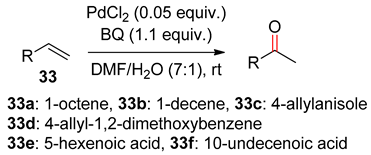

ESI–MS monitoring of the reactions showed that dinuclear palladium complexes were more involved as active catalytic intermediates than mononuclear species. Tests of complexation suggested a reoxidation of Pd occurring before the decoordination of the product. These studies associated to kinetic experiments led us to propose the catalytic cycle depicted in Scheme 12, in which intermediates having the Pd atom in mauve color correspond to clusters detected by ESI–MS.
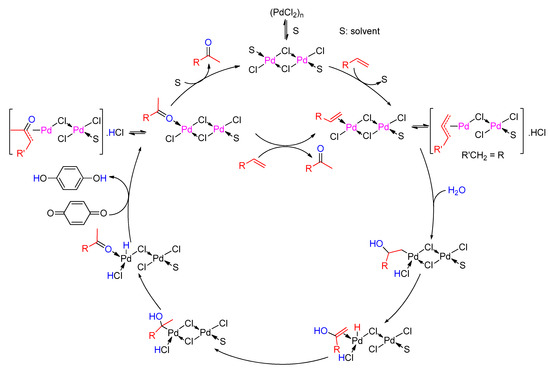
Scheme 12.
Proposed catalytic cycle for the Wacker reaction in DMF/H2O in the presence of benzoquinone.
Compared with the usual mechanism, the most important differences are the involvement of mainly dinuclear Pd species and the reoxidation of a Pd-hydride complex before decomplexation of the ketone.
7. Cyclohexanone Dehydrogenation
In 1982, we disclosed the room temperature Pd(OCOCF3)2-catalyzed dehydrogenation of cyclohexanones under oxygen atmosphere (Equation (21)) [96]. Pd procedures were previously reported but using mainly stoichiometric amounts of PdII [97].
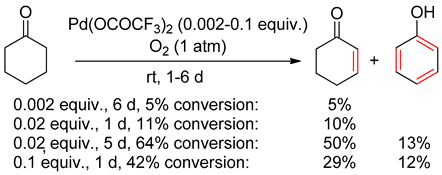

Cyclohexenone was selectively produced at low conversion. Increase of the latter led to over-oxidation giving phenol. The proposed catalytic cycle (Scheme 13) maintains the formal oxidation state of PdII throughout the reaction. Coordination of cyclohexanone or its enol form to Pd(OCOCF3)2 provides 13A, which led to oxo-η3-allyl palladium complex 13B in liberating CF3CO2H. Hydrogen abstraction by palladium provides 13C which undergoes insertion of oxygen and ligand exchange giving 2-cyclohexenone and hydroperoxy complex 13D. The latter leads to H2O2 and either 13B (path a) or 13A by reacting with CF3CO2H (path b).
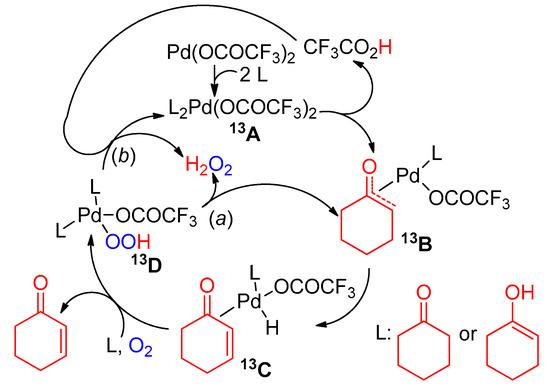
Scheme 13.
Pd(OCOCF3)2-catalyzed dehydrogenation of cyclohexanone.
This oxidation process was, in 1982, one of the first reports on the regeneration of active PdII species using only oxygen [98,99,100]. The pathway leading to PdOOH from PdH and O2, that is 13D from 13C remains however a matter of debate [98,99,100,101].
A number of procedures are now available for the Pd-catalyzed dehydrogenation of carbonyl compounds [102]. Moreover, such a dehydrogenation may be a step of a domino reaction involving the Heck reaction, decarboxylative Heck reaction or dehydrogenative Heck reaction [103].
8. Dehydrogenative Heck Reaction
Disclosed in 1970, the Heck reaction is traditionally the synthesis of an arylalkene from the Pd0-catalyzed cross-coupling of an aryl halide with an alkene [104]. Previously, Fujiwara’s team reported the synthesis of stilbene from the reaction of benzene with styrene and PdCl2, leading to two turnovers of palladium [105]. Such a cross-coupling, for which we adopted the name “dehydrogenative Heck reaction” (DHR) [106], may be more respective of the atom economic principle [107], and has been intensively studied over the last twenty years [108].
Our studies focused on the coupling of furan 34 with styrene. Screening various experimental conditions initially led to the best results with catalytic Pd(OAc)2 and the BQ/Cu(OAc)2/O2 oxidizing system (Equation (22)). The method was used for the DHR of various furans and styrenes with high regio- and stereoselectivities (30 examples, 50%–78% yields) [109].


Kinetic investigations showed an induction period which depends on the nature of the furan, the transformation being faster with electron-rich furans. This led us to investigate the influence of ligands and solvents on the activity of the catalyst. The use of DMSO/AcOH as solvent mixture and BQ as oxidant led to a catalytic system showing no induction period at room temperature, leading to cross-coupling of furans and thiophenes with styrenes, and compatible with halogenated substrates such as 35 and 36 (Equation (23)) [110]. The positive influence of DMSO on the efficiency of Pd(OAc)2-catalyzed oxidations is largely documented in the literature [111,112]. Ligation of DMSO to the trimer [Pd(OAc)2]3 affords the dimeric active species Pd(OAc)2(DMSO)2 [113,114], which may react with the arene leading to ArPdOAc(DMSO)2. Subsequent ligand exchange with BQ could give the less electron-rich species ArPdOAc(BQ)(DMSO), which would be susceptible to easily coordinate to electron-rich styrenes [110].


The mechanism of the reaction of 34 with tert-butyl acrylate under these conditions (Equation (24)) has been investigated by ESI–MS leading to identification of clusters corresponding especially to PdII and Pd0 intermediates 14A, 14B and 14C, leading us to propose the catalytic cycle shown Scheme 14 [115].


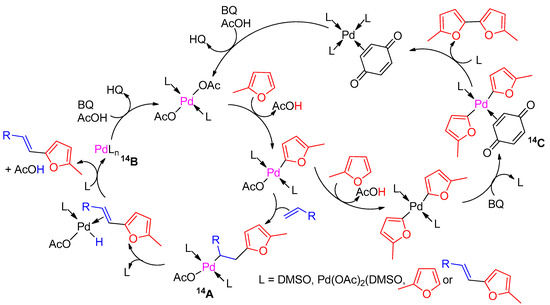
Scheme 14.
PdII-catalyzed C-H activation.
Catalytic amounts of metallic co-oxidants are often required for efficient DHRs under oxygen [108]. We observed, however, that such additives are not always beneficial. Indeed, the room temperature Pd(OAc)2-catalyzed reaction of 34 with styrene in oxygenated DMSO/AcOH afforded the cross-coupling product in higher yield in their absence (Equation (25)). Thus, these mild experimental conditions were used for the efficient DHR of furans, thiophenes and indoles with styrenes (29 examples, 42%–95% yields) [116]. ESI–MS studies of mixtures of Pd(OAc)2 and AgOAc have shown the formation of mixed species; which could be inactive towards the DHR.


The reaction of thiophene 37 with a hindered alkene such as methyl cinnamate under conditions of Equation (24) occurred with 5% conversion leading to traces of DHR product 38 [117]. With AcOH as the solvent instead of the AcOH/DMSO mixture, the conversion increased to 20%. Testing various ligands led to an efficient DHR with 4,5-diazafluorenone (Equation (26)). Moreover, increase of the temperature to 60 °C with O2 instead of BQ led to 38 in 90% isolated yield. Consequently, these conditions have been used for the cross-coupling of furans and thiophenes with various hindered alkenes (19 examples, 51%–96% yield). According to kinetics and competitive experiments as well as ESI–MS studies, 4,5-diazafluorenone influences the C–H bond activation, the alkene insertion, the stereoselectivity and the regeneration of the catalyst [117].
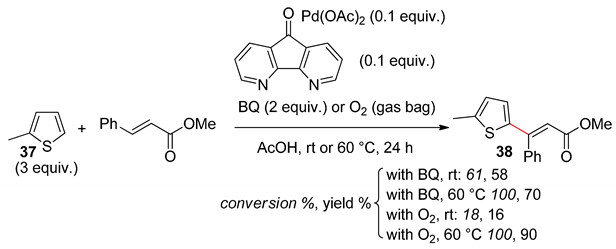

Under conditions of Equation (24) except the presence of DMSO, a low yield of the DHR product 39 was obtained from the sluggish reaction of 34 with allylbenzene (Equation (27)) [118]. Surprisingly, addition of MeCN as a co-solvent suppressed the formation of 39 and increased the conversion leading to a 1:1 mixture of difurylalkanes 40 and 41. Moreover, switching to Pd(OCOCF3)2 as the catalyst increased the 40 + 41 yield to 94% (Equation (27)).
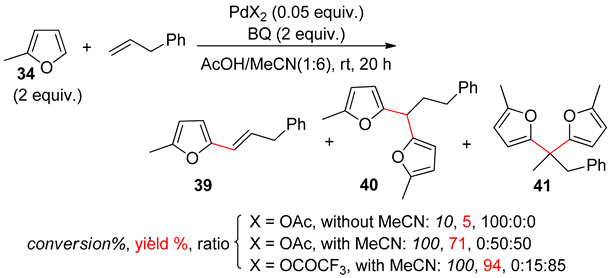

Suspecting the formation of 41 from prop-1-en-1-ylbenzene via isomerization of allylbenzene [82], the reaction was repeated with styrene [118]. Difurylalkanes were also obtained (Equation (28)). Labelling experiments led to assignment of the hydrogen shifts shown in Equation (28) and, associated ESI–MS studies, to propose the catalytic cycle depicted in Scheme 15 [118].


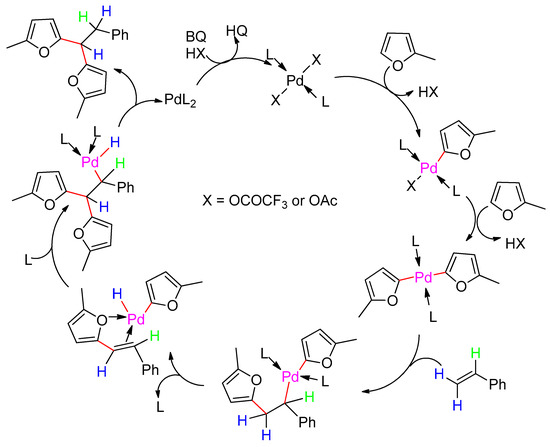
Scheme 15.
Diaddition of 2-methylfuran to styrene.
9. Conclusions
Starting at the end of the 1970s with oxidations of CH or CH2 units under UV light, our research evolved towards light-free reactions in various media: organic solvents, water, molten salts, leading to alcohol oxidation, dehydrogenation, etherification or formation of C–C bonds. We have always been strongly focused on the mechanisms; these lead us to various proposals, especially those based on ESI–MS results. Some reactions and mechanisms have been serendipitously discovered [119], but nevertheless, in most cases, they were the fruit of deep investigations and reflection, rather than good fortune.
Funding
This research received no external funding.
Acknowledgments
We are grateful to colleagues and students from the Universities of Grenoble, Lille, Marseille, Moscow, Prague, Reims and York whose names are cited in the references, for their involvement in the above reactions. We thank CNRS for the freedom in the choice of our research activities.
Conflicts of Interest
The authors declare no conflict of interest.
References
- Muzart, J.; Pale, P.; Pète, J.-P. Preparation of conjugated carbonyl compounds by photolysis of η3-allylpalladium complexes. J. Chem. Soc. Chem. Commun. 1981, 14, 668–669. [Google Scholar] [CrossRef]
- Trost, B.M.; Metzner, P.J. Reaction of olefins with palladium trifluoroacetate. J. Am. Chem. Soc. 1980, 102, 3572–3577. [Google Scholar] [CrossRef]
- Muzart, J.; Pale, P.; Pète, J.-P. Photoactivation of alkenes oxidation by molecular oxygen in the presence of palladium. Tetrahedron Lett. 1982, 23, 3577–3578. [Google Scholar] [CrossRef]
- Muzart, J.; Pale, P.; Pète, J.-P. Catalyse par le palladium et la lumière ultra-violette de l’oxydation d’alcènes par l’oxygène moléculaire. J. Organomet. Chem. 1988, 353, 267–273. [Google Scholar] [CrossRef]
- Sen, A.; Lai, T.-W. Catalytic isomerization of alkenes by palladium(II) compounds. An alternative mechanistic view. Inorg. Chem. 1981, 20, 4036–4038. [Google Scholar] [CrossRef]
- Sen, A.; Lai, T.-W. Mechanism of palladium(II)-catalyzed carbon-carbon double bond isomerization in olefins. Inorg. Chem. 1984, 23, 3257–3258. [Google Scholar] [CrossRef]
- Muzart, J.; Riahi, A.; Pète, J.-P. Oxydation régiosélective de sulfones allyliques catalysée par le palladium et la lumière: Formation d’aldéhydes et alcools α,β-éthyléniques β-sulfonylés. J. Organomet. Chem. 1985, 280, 269–279. [Google Scholar] [CrossRef]
- Riahi, A.; Cossy, J.; Muzart, J.; Pète, J.-P. Palladium catalyzed oxidation of allylsilanes with U.V. light and molecular oxygen. Tetrahedron Lett. 1985, 26, 839–842. [Google Scholar] [CrossRef]
- Muzart, J.; Riahi, A. Oxygenation under UV light of allylsilanes catalyzed by palladium(II) and of (.eta. 3-allyl)palladium complexes: A mechanistic approach. Organometallics 1992, 11, 3478–3481. [Google Scholar] [CrossRef]
- Hütter, P.; Butters, T.; Winter, W.; Handschuh, D.; Woelter, W. Die kristall- und molekülstruktur des dimeren π-allylpalladiumchlorid-Complexes von testosteron. Liebigs Ann. Chem. 1982, 1111–1120. [Google Scholar] [CrossRef]
- Hughes, R.P.; Day, C.S. Steric blocking of η3 → η1 → η3 isomerizations of an η3-allylic ligand. Crystal and molecular structures of 1,3-chloropalladation products of cis-9-methylenebicyclo [6.1.0]nonane and cis-7-methylenebicyclo[4.1.0]heptane. Organometallics 1982, 1, 1221–1225. [Google Scholar] [CrossRef]
- Keinan, E.; Roth, Z. Regioselectivity in organo-transition-metal chemistry. A new indicator substrate for classification of nucleophiles. J. Org. Chem. 1983, 48, 1769–1772. [Google Scholar] [CrossRef]
- Walling, C.; Zavitsas, A.A. The copper-catalyzed reaction of peresters with hydrocarbons. J. Am. Chem. Soc. 1963, 85, 2084–2090. [Google Scholar] [CrossRef]
- Corey, E.J.; Walker, J.C. Organoiron-mediated oxygenation of allylic organotin compounds. A possible chemical model for enzymatic lipoxygenation. J. Am. Chem. Soc. 1987, 109, 8108–8109. [Google Scholar] [CrossRef]
- Kliegman, J.M. The palladium(II) cleavage of allylsilanes. J. Organomet. Chem. 1971, 29, 73–77. [Google Scholar] [CrossRef]
- Crozet, M.P.; Muzart, J.; Pale, P.; Tordo, P. Photolyse des complexes η3--allylpalladium: Étude par résonnance paramagnétique électronique des nitroxydes allyliques formés en présence de nitrosodurène. J. Organomet. Chem. 1983, 244, 191–200. [Google Scholar] [CrossRef]
- Vermeersch, G.; Marko, J.; Muzart, J. Photoreactivity of η3-allylpalladium complexes studied by CINDP. J. Chem. Soc. Perkin Trans. 1986, 383–389. [Google Scholar] [CrossRef]
- Muzart, J.; Hénin, F. Activation de liaisons carbone-hydrogène d’alcanes par l’association de complexes métalliques électrophiles et de lumière ultra-violette. C. R. Acad. Sci. Paris Série II 1988, 307, 479–482. [Google Scholar]
- Barton, D.H.R.; Boivin, J.; Gastiger, M.; Morzycki, J.; Hay-Motherwell, R.S.; Motherwell, W.B.; Ozbalik, N.; Schwartzentruber, K.M. Functionalization of saturated hydrocarbons. Part 4. The Gif system for selective oxidation using molecular oxygen. J. Chem. Soc. Perkin Trans. 1986, 947–955. [Google Scholar] [CrossRef]
- Muzart, J.; Nizova, G.V.; Riahi, A.; Shul’pin, G.B. Oxidation of alkanes by peroxide complexes of palladium. J. Gen. Chem. USSR 1992, 62, 964. [Google Scholar]
- Muzart, J.; Pète, J.-P.; Riahi, A. Palladium-catalyzed allylic oxidation of 1-(p-toluenesulfonyl)-2-propene and 1-(trimethylsilyl)-1-(p-toluenesulfonyl)-2-propene. J. Organomet. Chem. 1987, 331, 113–119. [Google Scholar] [CrossRef]
- Mimoun, H.; Charpentier, R.; Mitschler, A.; Fischer, J.; Weiss, R. Palladium(II) tert-butyl peroxide carboxylates. New reagents for the selective oxidation of terminal olefins to methyl ketones. On the role of peroxymetalation in selective oxidative processes. J. Am. Chem. Soc. 1980, 102, 1047–1057. [Google Scholar] [CrossRef]
- Muzart, J. Oxydation d’alcènes: Induction par les métaux de la formation de liaison C-O en position allylique. Bull. Soc. Chim. Fr. 1986, 1, 65–77. [Google Scholar]
- Beccalli, E.M.; Broggini, G.; Martinelli, M.; Sottocornola, S. C-C, C-O, C-N bond formation on sp2 carbon by Pd(II)-catalyzed reactions involving oxidant agents. Chem. Rev. 2007, 107, 5318–5365. [Google Scholar] [CrossRef] [PubMed]
- Thiery, E.; Aouf, C.; Belloy, J.; Harakat, D.; Le Bras, J.; Muzart, J. Palladium-catalyzed allylic acyloxylation of terminal alkenes in the presence of a base. J. Org. Chem. 2010, 75, 1771–1774. [Google Scholar] [CrossRef] [PubMed]
- Skapski, A.C.; Smart, M.L. The crystal structure of trimeric palladium(II) acetate. J. Chem. Soc. Chem. Commun. 1970, 11, 658–659. [Google Scholar] [CrossRef]
- Muzart, J. Palladium-catalysed oxidation of primary and secondary alcohols. Tetrahedron 2003, 59, 5789–5816. [Google Scholar] [CrossRef]
- Muzart, J. Sodium perborate and sodium percarbonate in organic synthesis. Synthesis 1995, 1995, 1325–1347. [Google Scholar] [CrossRef]
- McKillop, W.R. Sanderson, Sodium perborate and sodium percarbonate: Cheap, safe and versatile oxidising agents for organic synthesis. Tetrahedron 1995, 51, 6145–6166. [Google Scholar] [CrossRef]
- Adogen 464 is a registered trademark of Ashland Chemical Co. for methyltrialky1(C8-C10) ammonium chloride. CAS Number 72749-59-8.
- Aït-Mohand, S.; Lunak, S.; Muzart, J. Chlorides and acetylacetonates of transition metals as catalysts for the oxidation of 1-indanol by sodium percarbonate. Chem. Ber. 1997, 130, 1655–1658. [Google Scholar] [CrossRef]
- Aït-Mohand, S.; Hénin, F.; Muzart, J. Palladium(II)-mediated oxidation of alcohols using 1,2-dichloroethane as Pd(0) reoxidant. Tetrahedron Lett. 1995, 36, 2473–2476. [Google Scholar] [CrossRef]
- Rothenberg, G.; Humbel, S.; Muzart, J. Palladium-catalyzed oxidation of alcohols to carbonyl compounds with 1,2-dichloroethane as the primary oxidant: A theoretical study. J. Chem. Soc. Perkin Trans. 2001, 10, 1998–2004. [Google Scholar] [CrossRef]
- Bouquillon, S.; du Moulinet d’Hardemare, A.; Averbuch-Pouchot, M.-T.; Hénin, F.; Muzart, J. Synthesis and characterization of monomeric and dimeric palladium(II)-ammonium complexes; Their use for the catalytic oxidation of alcohols. Polyhedron 1999, 18, 3511–3516. [Google Scholar] [CrossRef]
- Aït-Mohand, S.; Muzart, J. Palladium-catalyzed oxidative cyclization of 1,4-and 1,5-diols in 1,2-dichloroethane. J. Mol. Catal. A Chem. 1998, 129, 135–139. [Google Scholar] [CrossRef]
- Aït-Mohand, S. Catalyse de réactions d’oxydation: utilisation du percarbonate de sodium et régénération d’espèces palladiées actives par le 1,2-dichloroéthane. Doctoral Thesis, Reims University, Reims, France, 1997. [Google Scholar]
- Taniguchi, T.; Ogasawara, K. Specific asymmetric mono-epoxidation of meso 2,3-syn-bis-allylic alcohols having a bicyclo[2.2.1]heptane framework. Tetrahedron Lett. 1997, 38, 433–436. [Google Scholar] [CrossRef]
- Taniguchi, T.; Goto, Y.; Ogasawara, K. Preparation of a promising cyclobutanone chiral building block: Utilization its stereochemistry and utilization. Synlett 1997, 1997, 707–709. [Google Scholar] [CrossRef]
- Jaeschke, G.; Seebach, D. Highly enantioselective ring opening of cyclic meso-anhydrides to isopropyl hemiesters with Ti-TADDOLates: An alternative to hydrolytic enzymes? J. Org. Chem. 1998, 63, 1190–1197. [Google Scholar] [CrossRef]
- March, J. Advanced Organic Chemistry, 4th ed.; John Wiley: New York, NY, USA, 1992; p. 393. [Google Scholar]
- Aït-Mohand, S.; Hénin, F.; Muzart, J. Palladium-catalyzed oxidations: Inhibition of a Pd-H elimination by coordination of a remote carbon carbon double bond. Organometallics 2001, 20, 1683–1686. [Google Scholar] [CrossRef]
- Chung, K.; Banik, S.M.; De Crisci, A.G.; Pearson, D.M.; Blake, T.R.; Olsson, J.V.; Ingram, A.J.; Zare, R.N.; Waymouth, R.M. Chemoselective Pd-catalyzed oxidation of polyols: Synthetic scope and mechanistic studies. J. Am. Chem. Soc. 2013, 135, 7593–7602. [Google Scholar] [CrossRef]
- Li, Y.; Lin, Z. Understanding the reaction mechanisms of Pd-catalysed oxidation of alcohols and domino oxidation-arylation reactions using phenyl chloride as an oxidant. Org. Chem. Front. 2014, 1, 1188–1196. [Google Scholar] [CrossRef]
- Corey, E.J.; Palani, A. A method for the selective oxidation of 1,4-diols to lactols. Tetrahedron Lett. 1995, 36, 3485–3488. [Google Scholar] [CrossRef]
- Corey, E.J.; Palani, A. A mechanistic model for the selective oxidation of 1,4-diols to γ-lactols by o-iodoxybenzoic acid. Tetrahedron Lett. 1995, 36, 7945–7948. [Google Scholar] [CrossRef]
- Lieb, F.; Niewöhner, U.; Wendisch, D. 6-(3-Carbamoylbicyclo[2.2.1]hept-2-yl)hexansäuren, eine neue klasse von TxA2-antagonisten. Liebigs Ann. Chem. 1987, 1987, 607–615. [Google Scholar] [CrossRef]
- For the introduction of this expression and its use, see, respectively: Berson, J.A.; Willcott, M.R. Bredt rule Interdictions of cyclopropane rearrangements.The vinylnortricyclenes. J. Org. Chem. 1965, 30, 3569–3572. [CrossRef]
- Baldwin, J.E.; Dunmire, D.A. The “No Reaction” reaction of 1-vinylnortricyclene to tricyclo[4.2.1.03,7]non-3-ene. J. Org. Chem. 2000, 65, 6791–6794. [Google Scholar] [CrossRef] [PubMed]
- Bouquillon, S.; Hénin, F.; Muzart, J. The critical role of the coordination environment of palladium dichloride on the course of its reaction with secondary benzylic alcohols; selective oxidation or etherification catalysts. Organometallics 2000, 19, 1434–1437. [Google Scholar] [CrossRef]
- Sen, A.; Lai, T.-W. Catalysis by solvated transition-metal cations. Novel catalytic transformations of alkenes by tetrakis(acetonitrile)palladium ditetrafluoroborate. Evidence for the formation of incipient carbonium ions as intermediates. J. Am. Chem. Soc. 1981, 103, 4627–4629. [Google Scholar] [CrossRef]
- Sen, A.; Lai, T.-W. Oligomerization and isomerization of olefins by η3-allyl complexes of palladium. The role of the allyl group. Organometallics 1983, 2, 1059–1060. [Google Scholar] [CrossRef]
- Lipshutz, B.H.; Pollart, D.; Monforte, J.; Kotsuki, H. Pd(II)-catalyzed acetal/ketal hydrolysis/exchange reactions. Tetrahedron Lett. 1985, 26, 705–708. [Google Scholar] [CrossRef]
- Tenaglia, A.; Kammerer, F. Palladium(II)-catalyzed dehydrative cyclization of cis-4-alkylcycloalken-2-ols. Synthesis of tricyclic spiroketals in a one-pot sequence. Synlett 1996, 1996, 576–578. [Google Scholar] [CrossRef]
- Salehi, P.; Iranpoor, N.; Behbahani, F.K. Selective and efficient alcoholyses of allylic, secondary-and tertiary benzylic alcohols in the presence of iron (III). Tetrahedron 1998, 54, 943–948. [Google Scholar] [CrossRef]
- Tamaru, Y.; Yamamoto, Y.; Yamada, Y.; Yoshida, Z. Palladium catalyzed oxidations of secondary alcohols. Tetrahedron Lett. 1979, 20, 1401–1404. [Google Scholar] [CrossRef]
- Tamaru, Y.; Yamada, Y.; Inoue, K.; Yamamoto, Y.; Yoshida, Z. Oxidation of primary and secondary alcohols by the catalysis of palladium. J. Org. Chem. 1983, 48, 1286–1292. [Google Scholar] [CrossRef]
- Bessmertnykh, A.; Hénin, F.; Muzart, J. Palladium-catalyzed oxidation of benzylated aldose hemiacetals to lactones. Carbohydr. Res. 2004, 339, 1377–1380. [Google Scholar] [CrossRef] [PubMed]
- Welton, T. Room-temperature ionic liquids. Solvents for synthesis and catalysis. Chem. Rev. 1999, 99, 2071–2083. [Google Scholar] [CrossRef] [PubMed]
- Dupont, J.; de Souza, R.F.; Suarez, P.A.Z. Ionic liquid (molten salt) phase organometallic catalysis. Chem. Rev. 2002, 102, 3667–3692. [Google Scholar] [CrossRef] [PubMed]
- Ionic Liquids in Synthesis; Wasserscheid, P., Welton, T., Eds.; Wiley: Weinheim, Germany, 2003. [Google Scholar]
- Muzart, J. Ionic liquids as solvents for catalyzed oxidations of organic compounds. Adv. Synth. Catal. 2006, 348, 275–295. [Google Scholar] [CrossRef]
- Betza, D.; Altmann, P.; Cokoja, M.; Herrmann, W.A.; Kuhn, F.E. Recent advances in oxidation catalysis using ionic liquids as solvents. Coord. Chem. Rev. 2011, 255, 1518–1540. [Google Scholar] [CrossRef]
- Dai, C.; Zhang, J.; Huang, C.; Lei, Z. Ionic liquids in selective oxidation: Catalysts and solvents. Chem. Rev. 2017, 117, 6929–6983. [Google Scholar] [CrossRef]
- Bouquillon, S.; Ganchegui, B.; Estrine, B.; Hénin, F.; Muzart, J. Heck arylation of allylic alcohols in molten salts. J. Organomet. Chem. 2001, 634, 153–156. [Google Scholar] [CrossRef]
- Keresszegi, C.; Mallat, T.; Baiker, A. Selective transfer dehydrogenation of aromatic alcohols on supported palladium. New J. Chem. 2001, 25, 1163–1167. [Google Scholar] [CrossRef]
- Murahashi, S.; Shimura, T.; Moritani, I. Conversion of alcohols into unsymmetrical secondary or tertiary amines by a palladium catalyst. Synthesis of N-substituted pyrroles. Chem. Commun. 1974, 22, 931–932. [Google Scholar] [CrossRef]
- Ganchegui, B.; Bouquillon, S.; Hénin, F.; Muzart, J. Palladium-catalyzed dehydrogenation of benzylic alcohols in molten ammonium salts, a recyclable system. Tetrahedron Lett. 2002, 43, 6641–6644. [Google Scholar] [CrossRef]
- Ganchegui, B. Transformations palladocatalysées et utilisation d’un sel fondu comme solvant. Doctoral Thesis, Reims University, Reims, France, 2004. [Google Scholar]
- Li, C.-J. Organic reactions in aqueous media—with a focus on carbon-carbon bond formation. Chem. Rev. 1993, 93, 2023–2035. [Google Scholar] [CrossRef]
- Li, C.-J.; Chen, L. Organic chemistry in water. Chem. Soc. Rev. 2006, 35, 68–82. [Google Scholar] [CrossRef] [PubMed]
- Hailes, H.C. Reaction solvent selection: The potential of water as a solvent for organic transformations. Org. Process Res. Dev. 2007, 11, 114–120. [Google Scholar] [CrossRef]
- Chanda, A.; Fokin, V.V. Organic synthesis “on water”. Chem. Rev. 2009, 109, 725–748. [Google Scholar] [CrossRef]
- Lamblin, M.; Nassar-Hardy, L.; Hierso, J.-C.; Fouquet, E.; Felpin, F.-X. Recyclable heterogeneous palladium catalysts in pure water: Sustainable developments in Suzuki, Heck, Sonogashira and Tsuji–Trost reactions. Adv. Synth. Catal. 2010, 352, 33–79. [Google Scholar] [CrossRef]
- Le Bras, J.; Muzart, J. From metal-catalyzed reactions with hydrosoluble ligands to reactions in and on water. Curr. Org. Synth. 2011, 8, 330–334. [Google Scholar] [CrossRef]
- Harry, N.A.; Radhika, S.; Neetha, M.; Anilkumar, G. Recent advances and prospects of organic reactions “on water”. ChemistrySelect 2019, 4, 12337–12355. [Google Scholar] [CrossRef]
- Le Bras, J.; Muzart, J. Water-soluble and reusable copper catalyst for the allylic benzoyloxylation of olefins. Tetrahedron Lett. 2002, 43, 431–433. [Google Scholar] [CrossRef]
- Meulemans, T.M.; Kiers, N.H.; Feringa, B.L.; van Leeuwen, P.W.N.M. Catalytic oxidation of homoallylalcohols to α-alkoxytetrahydrofurans by a Pd-nitro complex and molecular oxygen. Tetrahedron Lett. 1994, 35, 455–458. [Google Scholar] [CrossRef]
- Roshchin, A.I.; Kel’chevski, S.M.; Bumagin, N.A. Synthesis of benzofurans via Pd2+-catalyzed oxidative cyclization of 2-allylphenols. J. Organomet. Chem. 1998, 560, 163–167. [Google Scholar] [CrossRef]
- Larock, R.C.; Wei, L.; Hightower, T.R. Synthesis of 2H-1-benzopyrans by Pd-catalyzed cyclization of o-allylic phenols. Synlett 1998, 522–524. [Google Scholar] [CrossRef]
- Chevrin, C.; Le Bras, J.; Hénin, F.; Muzart, J. One-pot catalytic synthesis of 2-(1,2-dihydroxypropyl)-phenol derivatives from 2-allylphenols in aqueous media. Synthesis 2005, 2005, 2615–2618. [Google Scholar] [CrossRef]
- Wahlen, J.; De Vos, D.E.; Jacobs, P.A. Activation of hydrogen peroxide through hydrogen-bonding interaction with acidic alcohols: epoxidation of alkenes in phenol. Org. Lett. 2003, 5, 1777–1780. [Google Scholar] [CrossRef] [PubMed]
- Hassam, M.; Taher, A.; Arnott, G.E.; Green, I.R.; van Otterlo, W.A.L. Isomerization of allylbenzenes. Chem. Rev. 2015, 115, 5462–5569. [Google Scholar] [CrossRef]
- Lattanzi, A.; Senatore, A.; Massa, A.; Scettri, A. Novel highly regioselective VO(acac)2/TBHP mediated oxidation of o-alkenyl phenols to o-hydroxybenzyl ketones. J. Org. Chem. 2003, 68, 3691–3694. [Google Scholar] [CrossRef]
- Muzart, J. Pd-mediated reactions of epoxides. Eur. J. Org. Chem. 2011, 2011, 4717–4741. [Google Scholar] [CrossRef]
- Thiery, E.; Chevrin, C.; Le Bras, J.; Harakat, D.; Muzart, J. Mechanism insights into the palladiumII-catalyzed hydroalkoxylation of 2-allylphenols. J. Org. Chem. 2007, 72, 1859–1862. [Google Scholar] [CrossRef]
- Tsuji, J. Synthetic applications of the palladium-catalyzed oxidation of olefins to ketones. Synthesis 1984, 1984, 369–384. [Google Scholar] [CrossRef]
- Keith, J.A.; Henry, P.M. The Mechanism of the Wacker reaction: A tale of two hydroxypalladations. Angew. Chem. Int. Ed. 2009, 48, 9038–9049. [Google Scholar] [CrossRef] [PubMed]
- Comas-Vives, A.; Stirling, A.; Lledós, A.; Ujaque, G. The Wacker process: Inner- or outer-sphere nucleophilic addition? New insights from ab initio molecular dynamics. Chem. Eur. J. 2010, 16, 8738–8747. [Google Scholar] [CrossRef] [PubMed]
- Anderson, B.J.; Keith, J.A.; Sigman, M.S. Experimental and computational study of a direct O2-coupled Wacker oxidation: Water dependence in the absence of Cu salts. J. Am. Chem. Soc. 2010, 132, 11872–11874. [Google Scholar] [CrossRef][Green Version]
- Nair, N.N. Ligand exchanges and hydroxypalladation reactions of the Wacker process in aqueous solution at high Cl− concentration. J. Phys. Chem. B 2011, 115, 2312–2321. [Google Scholar] [CrossRef]
- Muzart, J. N,N-Dimethylformamide: Much more than a solvent. Tetrahedron 2009, 65, 8313–8323. [Google Scholar] [CrossRef]
- Le Bras, J.; Muzart, J. N,N-Dimethylformamide and N,N-dimethylacetamide as carbon, hydrogen, nitrogen and/or oxygen sources. In Solvents as Reagents in Organic Synthesis, Reactions and Applications; Wu, X.-F., Ed.; Wiley-VCH: Hoboken, NJ, USA, 2017; pp. 199–314. [Google Scholar]
- Le Bras, J.; Muzart, J. Recent uses of N,N-dimethylformamide and N,N-dimethylacetamide as reagents. Molecules 2018, 23, 1939. [Google Scholar] [CrossRef]
- Vasseur, A.; Muzart, J.; Le Bras, J. Ubiquitous benzoquinones, multitalented compounds for palladium-catalyzed oxidative reactions. Eur. J. Org. Chem. 2015, 2015, 4053–4059. [Google Scholar] [CrossRef]
- Harakat, D.; Muzart, J.; Le Bras, J. ESI-MS mechanistic studies of Wacker oxidation of alkenes: Dinuclear species as catalytic active intermediates. RSC Adv. 2012, 2, 3094–3099. [Google Scholar] [CrossRef]
- Muzart, J.; Pète, J.-P. Dehydrogenation of cyclohexanones catalyzed by palladium (II) trifluoroacetate. J. Mol. Catal. 1982, 15, 373–376. [Google Scholar] [CrossRef]
- Muzart, J. One-pot synthesis of α, β-unsaturated carbonyl compounds through palladium-mediated dehydrogenation of ketones, aldehydes, esters, lactones and amides. Eur. J. Org. Chem. 2010, 3779–3790. [Google Scholar] [CrossRef]
- Gligorich, K.M.; Sigman, M.S. Mechanistic questions about the reaction of molecular oxygen with palladium in oxidase catalysis. Angew. Chem. Int. Ed. 2006, 118, 6612–6615. [Google Scholar] [CrossRef] [PubMed]
- Muzart, J. Molecular oxygen to regenerate PdII active species. Chem. Asian J. 2006, 1, 508–515. [Google Scholar] [CrossRef] [PubMed]
- Gligorich, K.M.; Sigman, M.S. Recent advancements and challenges of palladiumII-catalyzed oxidation reactions with molecular oxygen as the sole oxidant. Chem. Commun. 2009, 26, 3854–3867. [Google Scholar] [CrossRef]
- Konnick, M.M.; Stahl, S.S. Reaction of molecular oxygen with a PdII-hydride to produce a PdII-hydroperoxide: Experimental evidence for an HX-reductive-elimination pathway. J. Am. Chem. Soc. 2008, 130, 5753–5762. [Google Scholar] [CrossRef]
- Le Bras, J.; Muzart, J. The Saegusa oxidation and related procedures. Org. React. 2019, 98, 1–172. [Google Scholar]
- Le Bras, J.; Muzart, J. Pd-catalyzed domino dehydrogenation/Heck-type reactions of carbonyl compounds. Adv. Synth. Catal. 2018, 360, 2411–2428. [Google Scholar] [CrossRef]
- The Mizoroki-Heck Reaction; Oestreich, M., Ed.; Wiley: Chichester, UK, 2009. [Google Scholar]
- Fujiwara, Y.; Moritani, I.; Matsuda, M.; Teranishi, S. Aromatic substitution of olefin. IV Reaction with palladium metal and silver acetate. Tetrahedron Lett. 1968, 9, 3863–3865. [Google Scholar] [CrossRef]
- Ferreira, E.M.; Zhang, H.; Stoltz, B.M. C–H bond functionalizations with palladium(II): Intramolecular oxidative annulations of arenes. Tetrahedron 2008, 64, 5987–6001. [Google Scholar] [CrossRef][Green Version]
- Trost, B.M. Atom economy—a challenge for organic synthesis: Homogeneous catalysis leads the way. Angew. Chem. Int. Ed. Engl. 1995, 34, 259–281. [Google Scholar] [CrossRef]
- Le Bras, J.; Muzart, J. Intermolecular dehydrogenative Heck reactions. Chem. Rev. 2011, 111, 1170–1214. [Google Scholar] [CrossRef] [PubMed]
- Aouf, C.; Thiery, E.; Le Bras, J.; Muzart, J. Palladium-catalyzed dehydrogenative coupling of furans with styrenes. Org. Lett. 2009, 11, 4096–4099. [Google Scholar] [CrossRef] [PubMed]
- Vasseur, A.; Muzart, J.; Le Bras, J. Dehydrogenative Heck reaction of furans and thiophenes with styrenes under mild conditions and influence of the oxidizing agent on the reaction rate. Chem. Eur. J. 2011, 17, 12556–12560. [Google Scholar] [CrossRef] [PubMed]
- Larock, R.C.; Hightower, T.R.J. Synthesis of unsaturated lactones via palladium-catalyzed cyclization of alkenoic acids. J. Org. Chem. 1993, 58, 5298–5300. [Google Scholar] [CrossRef]
- Muzart, J. Oxidation adjacent to oxygen of alcohols catalyzed by palladium/dimethyl sulfoxide. In Comprehensive Organic Synthesis, 2nd ed.; Molander, G.A., Knochel, P., Eds.; Elsevier: Amsterdam, The Netherlands; Oxford, UK, 2014; Volume 7, pp. 295–301. [Google Scholar]
- Stash, A.I.; Perepelkova, T.I.; Kravtsova, S.V.; Noskov, Y.G.; Romm, I.P. Palladium(II) diacetate complex with dimethyl sulfoxide: Structure and properties. Koord. Khim. 1998, 24, 40–43. Russ. J. Coord. Chem. 1998, 24, 36–39. [Google Scholar]
- Zierkiewicz, W.; Privalov, T. A theoretical study of the essential role of DMSO as a solvent/ligand in the Pd(OAc)2/DMSO catalyst system for aerobic oxidation. Organometallics 2005, 24, 6019–6028. [Google Scholar] [CrossRef]
- Vasseur, A.; Harakat, D.; Muzart, J.; Le Bras, J. ESI-MS studies of the dehydrogenative Heck reaction of furans with acrylates using benzoquinone as the reoxidant and DMSO as the solvent. J. Org. Chem. 2012, 77, 5751–5758. [Google Scholar] [CrossRef]
- Vasseur, A.; Harakat, D.; Muzart, J.; Le Bras, J. Aerobic dehydrogenative Heck reactions of heterocycles with styrenes: A negative effect of metallic co-oxidants. Adv. Synth. Catal. 2013, 355, 59–67. [Google Scholar] [CrossRef]
- Vasseur, A.; Laugel, C.; Harakat, D.; Muzart, J.; Le Bras, J. Ligand-promoted reactivity of alkenes in dehydrogenative Heck reactions of furans and thiophenes. Eur. J. Org. Chem. 2015, 2015, 944–948. [Google Scholar] [CrossRef]
- Thiery, E.; Harakat, D.; Le Bras, J.; Muzart, J. Pd-catalyzed oxidative coupling of 2-alkylfurans with olefins through C-H activation: Synthesis of difurylalkanes. Organometallics 2008, 27, 3996–4004. [Google Scholar] [CrossRef]
- Rulev, A.Y. Serendipity or the art of making discoveries. New J. Chem. 2017, 41, 4262–4268. [Google Scholar] [CrossRef]
© 2020 by the authors. Licensee MDPI, Basel, Switzerland. This article is an open access article distributed under the terms and conditions of the Creative Commons Attribution (CC BY) license (http://creativecommons.org/licenses/by/4.0/).